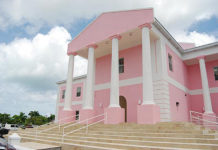BREAKING NEWS HAPPENING NOW <<< Breaking News HAPPENING NOW <<< BP is reporting the country’s first fatality of the epidemic Dengue Outbreak. Health officials in the position to know confirmed the victim, a former employee of the Nassau Guardian [1844 LTD], died today from dengue fever symptoms. The young man who worked in the technical department of the morning daily had contracted the sickness, which exacerbated his sickle cell conditions. No official word by health officials on the death has gone public.
Dengue and dengue haemorrhagic fever
What is dengue and dengue haemorrhagic fever?
Dengue and dengue haemorrhagic fever is a viral illness that is spread from human-to-human by the bite of dengue virus-carrying mosquitoes. It has become the most common arboviral illness (infections caused by viruses transmitted by arthropods such as mosquitoes and ticks) transmitted worldwide, with about two fifths of the world’s population now at risk. It is becoming a major public health problem.
Dengue infection causes a severe flu-like illness and is known as dengue fever. Some patients who have suffered dengue fever from one of four serotypes of dengue virus may be re-infected with another dengue serotype and develop a more severe form of dengue fever called dengue haemorrhagic fever. This is a leading cause of serious illness among children in some Asian countries and can lead to dengue shock syndrome, which may cause death.
Where does dengue fever come from and how is it spread?
Dengue viruses are small, spherical, single-stranded enveloped RNA viruses belonging to family Flaviviridae, genus Flavivirus. There are four distinct viral sertotypes; dengue virus 1 (DENV-1), dengue virus 2 (DENV-2), dengue virus 3 (DENV-3) and dengue virus 4 (DENV-4). Reports of dengue fever-like illnesses have been reported as far back as 265AD in Chinese medical writings. Nowadays, the virus has spread to more than 100 countries worldwide. Possible factors for dengue fever spread include:
- Overpopulation of areas leading to inadequate housing and public health systems (water, sewerage and waste management).
- Poor vector control, e.g., stagnant pools of water for mosquito breeding.
- Climate change (increased virus transmission has been linked to El Nino conditions).
- Increased international travel (recreational, business or military) to endemic areas.
The mosquito Aedes aegypti is the main Aedes species involved in transmitting the dengue virus from infected individuals to healthy contacts. These mosquitoes breed in and around ponds of stagnant water where humans live and usually bite during daylight hours. It is not unusual for entire families who develop infection within a 24- to 36-hour period to have been bitten by a single infected mosquito. When a human is infected the virus circulates the blood for 2-7 days (about the same time they suffer the fever). It is during this time that the Aedes mosquito may acquire the virus, then bite and infect another unsuspecting victim.
Currently the only continents that do not have dengue viral transmission are Europe and Antarctica, as these areas do not have the mosquito population to allow further spread of dengue from infected patients returning from other countries.
What are the signs and symptoms of dengue fever?
At about 24-36 hours after being bitten by a virus-carrying mosquito, patients will experience sudden high fever (as high as 41C). Just before fever develops, many patients experience chills, skin rash and facial flushing. Severe myalgia (muscle pain) of the lower back, arms and legs, and arthralgia (joint pain), especially of the knees and shoulders may also be present. Haemorrhagic symptoms may include small amounts of bleeding from the nose or gums. Other non-specific symptoms may include headache, fatigue, malaise, abdominal pain, sore throat and cough.
Cutaneous manifestations of dengue fever
As dengue fever is emerging as a major public health problem several studies have been conducted on the illness. A recent epidemic in India provided cases for one study that observed 256 “suspect cases” of dengue fever. It investigated the prevalence and type of skin manifestations in dengue viral infection (Thomas et al). Some of their findings are listed below:
- On the basis of WHO clinical criteria and simple laboratory tests, 124 patients were diagnosed with dengue viral infection, and these were studied further.
- 23.1% of patients were diagnosed with dengue fever, 66.9% with dengue haemorrhagic fever, and 3.2% with dengue shock syndrome.
- Skin manifestations were present in 46.8% of patients. This is consistent with other findings that report the frequency of skin problems in dengue to be between 40-50%.
- The most common problem was a maculopapular rash (red flat patches that may contain small raised spots) or a morbilliform rash (measles-like), with islands of skin sparing. In most cases the rash was generalised (widespread and over any part of the body), followed by involvement of the extremities (limbs of the body) and trunk. These eruptions were more common in patients with dengue fever.
- Patients with dengue haemorrhagic fever and dengue shock syndrome more commonly showed purpura, with petechiae (tiny pinpoint blood red spots under the surface of the skin) and ecchymoses (purplish blotches of bleeding under the skin).
- Most patients developed skin rash between the 3rd and 5th days after the onset of fever.
- In most cases (72.4%) the skin rash was asymptomatic. Patients who did experience some discomfort from skin rash complained of pruritus (itching).
- Mucosal involvement was more common in patients with dengue haemorrhagic fever and manifested as conjunctival infection, bleeding and crusting of the lips and tongue, and small vesicles on the soft palate.
What is the treatment of dengue fever?
There is no vaccine or specific treatment available against dengue infection. It is difficult to develop a vaccine because of the 4 different dengue viruses that cause the disease. A suitable vaccine would need to be able to protect against all 4 viruses.
Fortunately, dengue fever is usually self-limiting and resolves with supportive therapy. Paracetamol (acetaminophen) may be used to treat patients with fever. Aspirin and nonsteroidal anti-inflammatory drugs (NSAIDs) are not recommended. Fever that typically begins on the 3rd day after being infected usually lasts 5-7 days. Some patients may experience what is called saddleback fever; this is where fever subsides for a day and then returns. It is during this time that patients are at risk for developing dengue haemorrhagic fever or dengue shock syndrome.
Patients who deteriorate after a few days of fever and develop signs such as dehydration, tachycardia (rapid heart rate), reduced consciousness and drop in blood pressure must be monitored closely and receive appropriate medical treatment to prevent complications of dengue haemorrhagic fever and dengue shock syndrome. Improved recognition and experience with the effects and progression of dengue haemorrhagic fever by medical staff has reduced mortality rates from more than 20% to less than 1%.
How to prevent dengue fever
The best way to prevent dengue fever is by preventing spread of the virus by vector control. This means eliminating or controlling mosquito breeding sites. The dengue virus- carrying mosquito likes to breed in artificial containers and receptacles containing water. The following measures can be taken to reduce the breeding of mosquitoes.
- Cover tightly with a lid all water tanks, cisterns, barrels, rubbish containers, etc.
- Remove or empty water in old tyres, tin cans, bottles, trays, etc.
- Check and clean out clogged gutters and flat roofs where water may have settled.
- Change water regularly in pet water dishes, birdbaths and plant trays.
- Introduce larvivorous fish (e.g., guppy) to ornamental water features as these eat the mosquito larvae.
- Trim weeds and tall grasses as adult mosquitoes seek these for shade on hot days.
People can do the following to prevent themselves from being bitten by mosquitoes.
- Wear long sleeves and pants.
- Install secure screens to windows and doors to keep mosquitoes out.
- Use an insect repellent such as DEET.
- Sleep under mosquito curtains or nets, this is particularly important when children are sleeping or resting during daylight hours.
- In high-risk areas, insecticide sprays may be used to kill mosquitoes.









He was at Doctors, not pmh
R.i.P *****, Goon too soon, he was such a nice young man!!
AS for P.M.H and the Ministry of Health, they really ought to do better than what theyre doing.
I agree, Can’t one of the clinics be used to just deal with Denge Fever patients?
My brother just went to that place(pmh) about 2 days ago with denge fever symptoms and because of the long stalling lines and the horrible pains that he was having, he went back home…. I trust that he’s getting medical care at some other private place right now because I tell you PMH is just a hot mess!!..sorry to say!! WE NEED CHANGE THATS WHAT!!!!
‘he’ has a name and its Quincy Smith. A wonderful husband and devoted father to his namesake, a 7 week old son. RIP Quincy!
I know who you are talking about. We worked together years ago at Central Bank. This is so sad!!! I can’t believe it!
well, i think the ministry of health is down playing this whole thing. there are no beds at PMH. i feel more persons have died already and they have not revealed this. more steps/actions has to come from min of health on this issue. especially as it relates to hospital. they should have one of the govt clinics open 24 hours such as south beach clinic (which is actually a mini hospital) for strictly dengue cases after 6pm. then maybe we can alleviate the burden of PMH.
Would this be the same guy who was working as a computer tech @ the college of the Bahamas?
YES!
BP
How sad
Comments are closed.